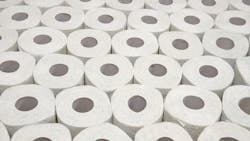Toilet paper a source of PFAS in wastewater, study finds
New research finds that toilet paper may be an unexpected source of per- and polyfluoroalkyl substances (PFAS) in wastewater systems, according to a press release by the American Chemical Society.
PFAS have been detected in many personal care products, such as cosmetics and cleansers, that people use every day and then wash down the drain. But not many researchers have considered whether toilet paper, which also ends up in wastewater, could be a source of the chemicals.
Some paper manufacturers add PFAS when converting wood into pulp, which can get left behind and contaminate the final paper product. In addition, recycled toilet paper could be made with fibers that come from materials containing PFAS.
So, Timothy Townsend and colleagues wanted to assess this potential input to wastewater systems, and test toilet paper and sewage for these compounds.
The study
The researchers gathered toilet paper rolls sold in North, South and Central America; Africa; and Western Europe and collected sewage sludge samples from U.S. wastewater treatment plants. Then they extracted PFAS from the paper and sludge solids and analyzed them for 34 compounds.
The primary PFAS detected were disubstituted polyfluoroalkyl phosphates (diPAPs) — compounds that can convert to more stable PFAS such as perfluorooctanoic acid, which is potentially carcinogenic. Specifically, 6:2 diPAP was the most abundant in both types of samples but was present at low levels, in the parts-per-billion range.
Then, the team combined their results with data from other studies that included measurements of PFAS levels in sewage and per capita toilet paper use in various countries. They calculated that toilet paper contributed about 4% of the 6:2 diPAP in sewage in the U.S. and Canada, 35% in Sweden and up to 89% in France.
Despite the fact that North Americans use more toilet paper than people living in many other countries, the calculated percentages suggest that most PFAS enter the U.S. wastewater systems from cosmetics, textiles, food packaging or other sources, the researchers say.
They add that this study identifies toilet paper as a source of PFAS to wastewater treatment systems, and in some places, it can be a major source.
